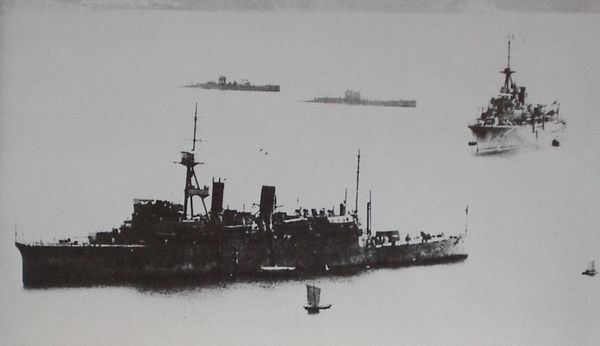Built 1922 – 1924 | Cost 2,900,000 JPY In commission 1923 – 1945 | |
 | ||
Builders Mitsubishi Heavy Industries | ||
The Jingei-class submarine tenders (迅鯨型潜水母艦,, Jingei-gata Sensuibokan) were a class of submarine tenders of the Imperial Japanese Navy (IJN), and served from the 1920s through World War II. Two vessels of this class were built between 1922 and 1924 under the Eight-eight fleet plan.
Contents
Background
The IJN planned to build over 100 submarines under the Eight-eight fleet plan, and it was recognized that support ships would be needed. The Jingei class was planned specifically for this purpose. The duties of a submarine tender included serving as a flagship for the Submarine Division Commander and as a depot ship for the nine Kaichū-type submarines in a division.
Design
At first, the Jingei class was planned as a 14,500 ton submarine tender. However, the specifications were revised to 8,500 tons (standing) class, as stipulated by the Washington Naval Treaty. This treaty would turn out to have a great impact on the Japanese shipbuilding industry. The IJN had intended to develop a large naval fleet, but under the treaty stipulations, the size of the intended fleet had to be greatly reduced. As a result, many shipbuilding companies incurred financial difficulty.
The IJN contracted the design details and construction of the Jingei to Mitsubishi. Naval contracts were directed toward Mitsubishi to prevent it from suffering the financial difficulty that had befallen other companies. The IJN handed only the required specifications to Mitsubishi, allowing for a greater freedom of design. The IJN recycled eight Tosa-class coal/oil-fired boilers for the development of the Jingei class of ships. Mitsubishi engineers worked on the design until the displacement of the Jingei was reduced to 8000 tons in the basic plan. However, the maximum speed was increased by 2.5 knots.
When Mitsubishi designers went to work developing the Katori-class cruiser, they implemented many design innovations that had been developed during their work on the Jingei. As a result, the Katori-class cruisers came to resemble the Jingei-class submarine tenders.
Service
The Jingei and its sister ship, the Chōgei, took over the duties of the submarine tenders Karasaki and Komahashi. The two new Jingei-class ships were welcomed by the sailors of the submarine fleets. However, the Jingei-class submarine tenders were unable to support the Kaidai-type submarines. This duty was taken up by the 5,500 ton Kuma- and Nagara-class cruisers.
In 1934, both Jingei-class ships were converted to training ships. Following the Tomozuru Incident that occurred on 13 March 1934, all ships of the Japanese Navy were subject to inspection and renovation of design flaws that would put the ship in danger of capsizing. Renovations were begun on the Jingei in November 1934 at the Sasebo Naval Arsenal. Overhaul of the Chōgei was started in October 1935 at Kure Naval Arsenal. Both ships were equipped with new ballast tanks and bilge pumps.
On 15 November 1940, the two Jingei-class ships were returned to Submarine Division Command and replaced the Takasaki and the Tsurugizaki, both of which had been flexibly designed and were converted to aircraft carriers. The IJN Jingei was assigned to the 7th Submarine Division, 4th Fleet. The IJN Chōgei was assigned to the 3rd Submarine Division, 6th Fleet.
